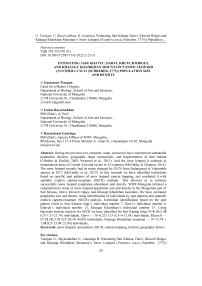Estimating Sair Khatuu, Darvi, Khuvch ridges, and Khasagt Khairkhan mountain's snow leopard (Panthera uncia (Schreber, 1775)) population size and density
Автор: Tsengun Gantumur, Bayarsaikhan Uudus, Gantulga Bayandonoi
Журнал: Вестник Бурятского государственного университета. Биология, география @vestnik-bsu-biology-geography
Рубрика: Биология
Статья в выпуске: 2, 2022 года.
Бесплатный доступ
During the previous two centuries, many carnivores have experienced substantial population declines, geographic range contractions, and fragmentation of their habitat (Ceballos & Ehrlich, 2002; Swenson et al., 2011). And the snow leopard is endemic to mountainous areas of Central Asia and occurs in 12 countries (McCarthy & Chapron, 2014). The snow leopard recently had its status changed by IUCN from Endangered to Vulnerable species in 2017 (McCarthy et al., 2017). In this research we have identified individuals based on specific spot patterns of snow leopard camera trapping, and combined it with spatially explicit capture-recapture (SECR) methods. This allowed us to estimate successfully snow leopard population abundance and density. WWF-Mongolia initiated a comprehensive study of snow leopard population size and density in the Mongolian part of Sair Khatuu, Darvi, Khuvch ridges, and Khasagt Khairkhan mountain. We have estimated population size and density using identification of individuals by spot patterns and spatially explicit capture-recapture (SECR) analysis. Individual identification based on the spot pattern result in Sair Khatuu ridge's individual number 7, Darvi's individual number 6, Khuvch's individual number 13, Khasgat Khairkhan's individual number 15. Using Bayesian statistic analysis for SECR we have identified for Sair Khatuu ridge N=8.30±2.48 (CI=7.11-21.74) individuals, Darvi - N=6.22±1.15 (CI=6-13.95) individuals, Khuvch - N=28.38±5.95 (CI=20.39-44.99) individuals, Khasagt Khairkhan mountain - N=15.74 ± 1.8 (CI=15.09-21.04) individuals.
Snow leopard, spot pattern, secr, camera trapping, territory geography factors, mongolia
Короткий адрес: https://sciup.org/148325384
IDR: 148325384 | DOI: 10.18101/2587-7143-2022-2-25-31
Список литературы Estimating Sair Khatuu, Darvi, Khuvch ridges, and Khasagt Khairkhan mountain's snow leopard (Panthera uncia (Schreber, 1775)) population size and density
- Nationwide Snow Leopard Population Assessment of Mongolia: Key Findings. October 2020. 38 p.
- McCarthy T., Mallon D., Jackson R., Zahler P., & McCarthy K. Panthera uncia, Snow Leopard // The IUCN Red List of Threatened Species. 2017. No. 8235. Р. 27. URL: http://dx.doi.org.
- Ceballos G., & Ehrlich P. R. Mammal Population Losses and the Extinction Crisis // Science. 2002. No. 296(5569). Р. 904-907. URL:.
- Heilbrun R. D., Silvy N. J., Tewes M. E., & Peterson M. J. Using Automatically Triggered Cameras to Individually Identify Bobcats // Wildlife Society Bulletin. 2003. No. 31(3). Р. 748-755.
- McCarthy T. M., & Chapron G. Snow Leopard Survival Strategy: Revised 2014 Version // Snow Leopard Network. 2014. Р. 1-145.
- Mishra C., Allen P., McCarthy T. O. M., Madhusudan M. D., Bayarjargal A., & Prins, H. H. T. The Role of Incentive Programs in Conserving the Snow Leopard\\rEl Papel de Programas de Incentivos en la Conservation del Uncia uncial // Conservation Biology. 2003. No. 17(6). Р. 1512-1520. URL: http://dx.doi.org.
- Munkhtsog B., Purevjav L., McCarthy T., & Bayrakgsmith R. Snow Leopards. Biodiversity of the World: Conservation from Genes to Landscapes. 2016. Р. 493-500. URL: 10.1016/B978-0-12-802213-9.00039-0 (accessed 16.04.2022).
- Swenson J. E., Taberlet P., & Bellemain E. Genetics and Conservation of European Brown Bears Ursus Arctos // Mammal Review. 2011. No. 41(2). Р. 87-98. URL: 10.1111/j.1365-2907.2010.00179.x (accessed 20.05.2022).


